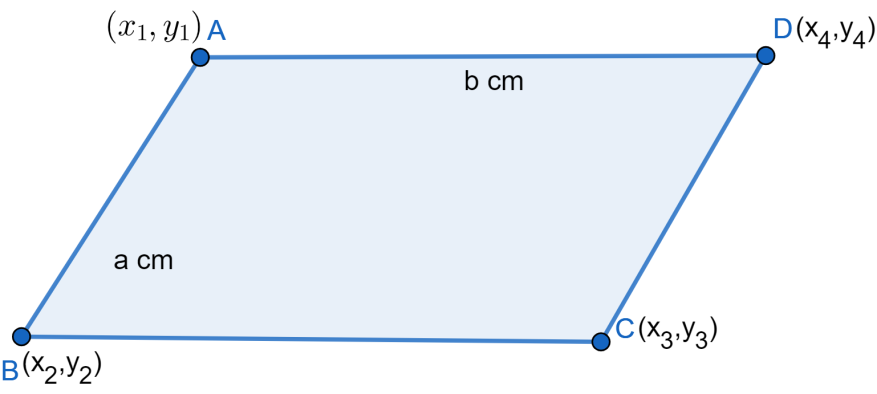
How do you find the area of a parallelogram with vertices?
Answer
456.6k+ views
Hint: For answering this question we have been asked to find the area of a parallelogram using its vertices. We know that the area of parallelogram is given as the product of base and height. We will join any one pair of vertices and apply Heron's formula and find the area of the two triangles since their sum will be the area of the parallelogram.
Complete step by step solution:
Now considering from the question we have been asked to find the area of parallelogram using its vertices.
From the basics of concept we know that the area of a parallelogram is given by the product of its base and height.
For finding the area of a parallelogram using only vertices one can join any one pair of diagonals and then apply heron’s formula in the two triangles formed.
Heron’s formula is given as
Since we know that the two opposite sides of a parallelogram are equal and parallel to each other we can find the area of a parallelogram by finding the length of height by finding the value of

We can find the length of sides of a parallelogram using the distance formula. We require height or angle between adjacent sides or diagonal to find the area else we cannot find the area.
Note: While answering questions of this type we should be sure with our concepts completely because this is a theory based question and we simply need to explain the theory behind finding the area of a parallelogram. For example we can find the area of a parallelogram with base length
Complete step by step solution:
Now considering from the question we have been asked to find the area of parallelogram using its vertices.
From the basics of concept we know that the area of a parallelogram is given by the product of its base and height.
For finding the area of a parallelogram using only vertices one can join any one pair of diagonals and then apply heron’s formula in the two triangles formed.
Heron’s formula is given as
Since we know that the two opposite sides of a parallelogram are equal and parallel to each other we can find the area of a parallelogram by finding the length of height by finding the value of

We can find the length of sides of a parallelogram using the distance formula. We require height or angle between adjacent sides or diagonal to find the area else we cannot find the area.
Note: While answering questions of this type we should be sure with our concepts completely because this is a theory based question and we simply need to explain the theory behind finding the area of a parallelogram. For example we can find the area of a parallelogram with base length
Recently Updated Pages
Master Class 4 Maths: Engaging Questions & Answers for Success

Master Class 4 English: Engaging Questions & Answers for Success

Master Class 4 Science: Engaging Questions & Answers for Success

Class 4 Question and Answer - Your Ultimate Solutions Guide

Master Class 11 Economics: Engaging Questions & Answers for Success

Master Class 11 Business Studies: Engaging Questions & Answers for Success

Trending doubts
Fill the blanks with the suitable prepositions 1 The class 9 english CBSE

Difference Between Plant Cell and Animal Cell

Given that HCF 306 657 9 find the LCM 306 657 class 9 maths CBSE

The highest mountain peak in India is A Kanchenjunga class 9 social science CBSE

What is the difference between Atleast and Atmost in class 9 maths CBSE

What is pollution? How many types of pollution? Define it





